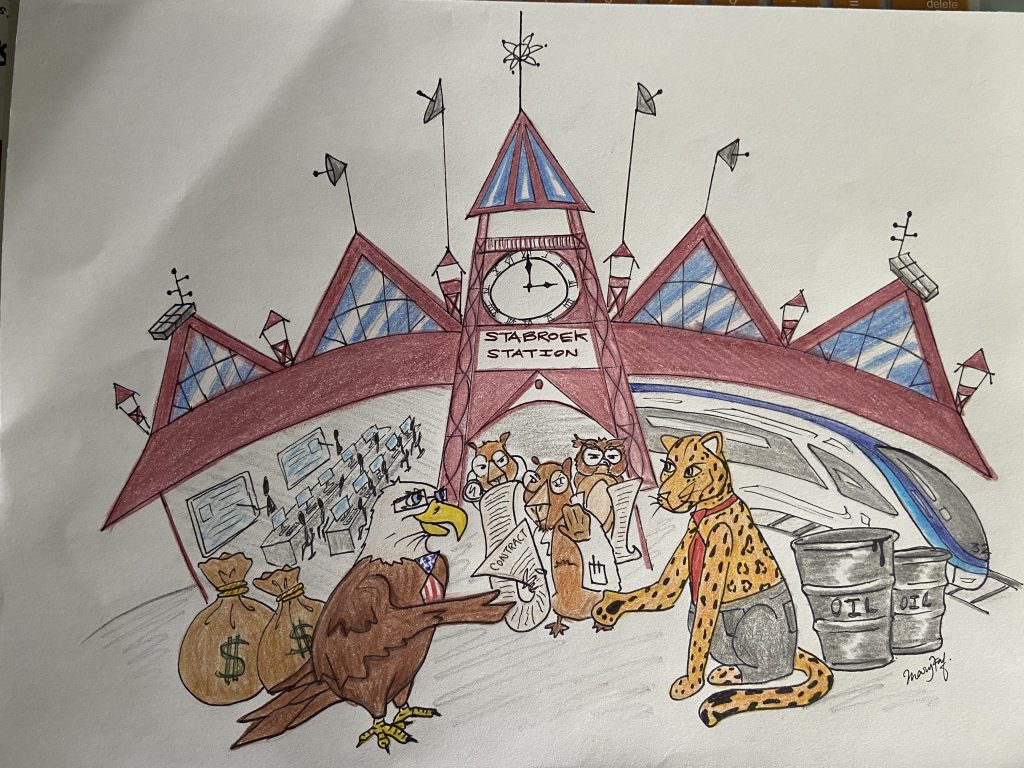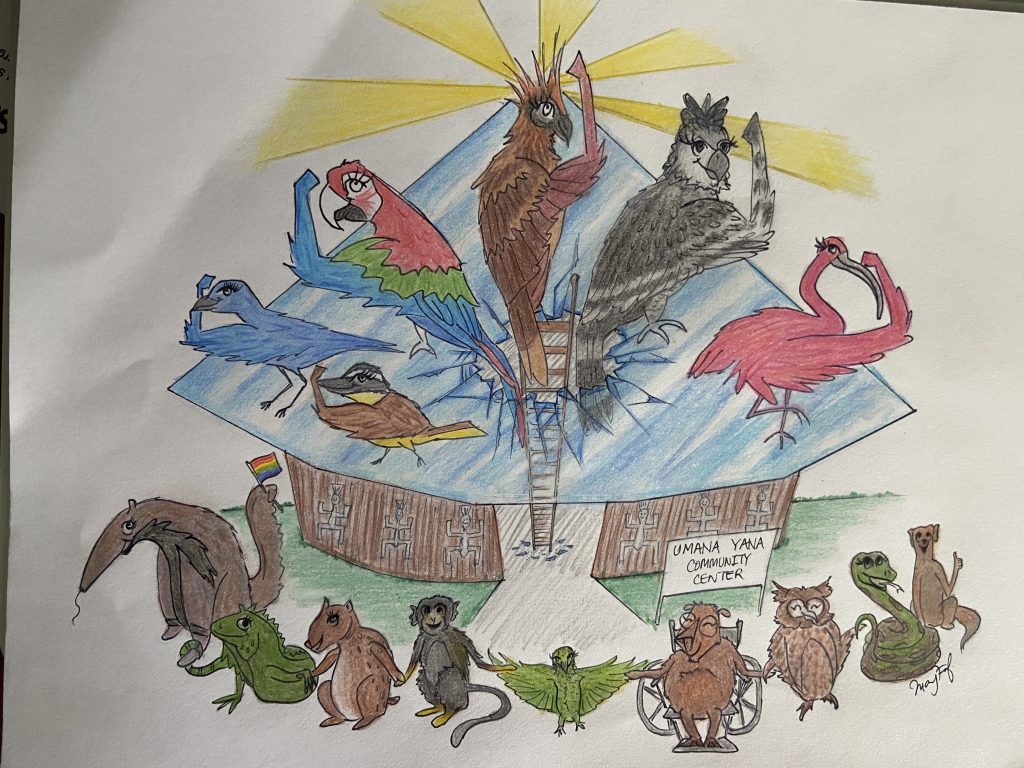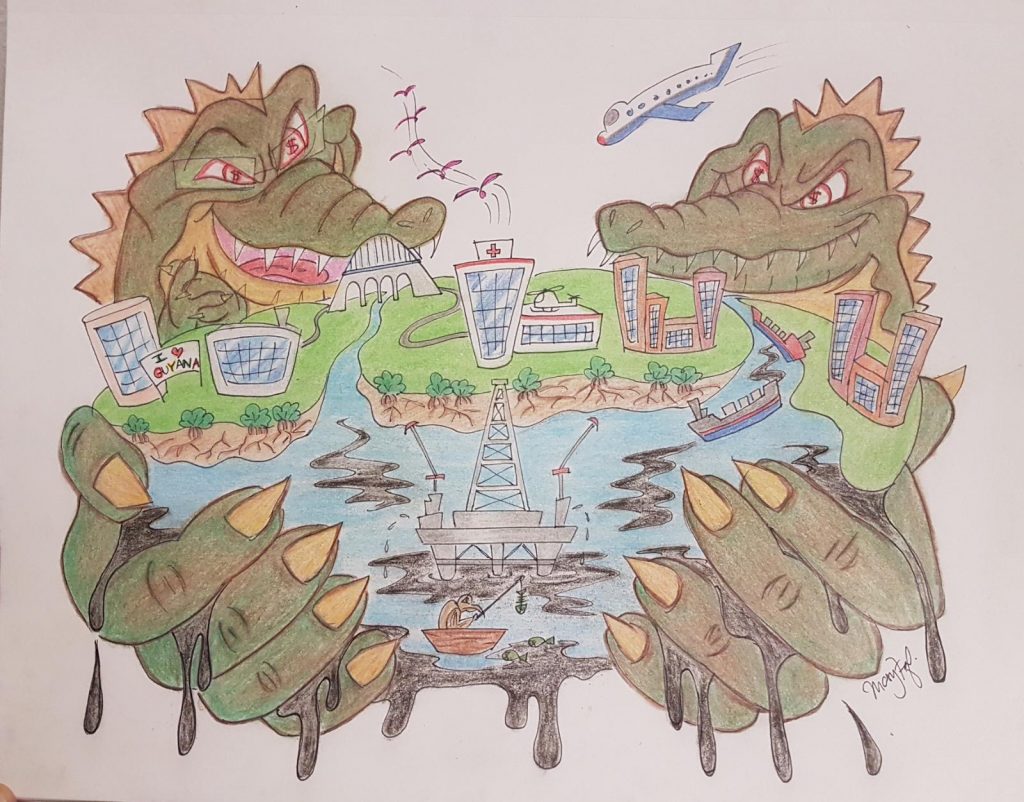Below you will find four stories written by Ana Correia composed of the hopes, fears and dreams of fellow Guyanese just like yourself. They are part of a Sustainable Development and Governance research project that she has been conducting since March of this year.
Correia is a Sustainable Development Master student.
All of the stories are constructed on the same timeline, starting from right now and going up to the year 2050. Correia has spoken to almost 40 Guyanese from all races and socio-economic classes – from businessmen and teachers to doctors and market vendors, from DJs and taxi drivers to lawyers and police officers, from artists and athletes to janitors and a Vice President.
She asks that you regard the stories with an open mind, a heaping teaspoon of salt, and a childlike imagination.
“Do not let the constraints of the present bog you down from daring to imagine different futures for our beautiful Guyana. Nothing is set in stone yet. And everything is possible.”
Information Age:

After the election scandal of 2020, the PPP emerges victorious and immediately gets to work orienting Guyana towards a future in oil. Recognizing the employment opportunities for young skilled Guyanese within the budding oil and gas sector, as well as the need to bring Guyana up to international standards of business, they decide to invest revenues in education and information technology – a business reform, if you will. Competence and efficiency are the new names of the game. They give lip service on ethnic reconciliation to placate the population’s growing cries for a solution to the tension, but nothing is concretely done. Instead, the public’s attention is redirected to high-profile economic projects like the Amaila Falls hydropower plant (which never materializes), and the Berbice deep-water harbour (which would probably be better suited in Essequibo). Race relations continue to deteriorate.
In 2022, the formal process for education reform begins. The government supplies every school with new computers so that every single Guyanese child may have the opportunity take courses and develop skills in I.T. UG is now free. Educators across the country are tasked with creating a relevant and forward-facing curriculum based on current opportunities within the country and foresight of what Guyana is going to need in the future. UG awards scholarships to its best and brightest educators to go abroad and specialize in needed fields so that they can bring that knowledge back home when they are finished.
In 2025, the PPP win again, but this time the third parties win enough seats to strip them of the majority they previously held in parliament. It’s a big step for accountability. To facilitate more efficient business both locally and with foreign enterprises, information systems across the country start being digitized. Data, statistics, public records and research start to become more widely available and improved access and information sharing catalyses the fight for transparency in government. Watchdog organizations have started popping up, holding the PPP mostly accountable. By 2030, all major credit cards are accepted just about everywhere, and reliable online banking is the norm. All utility bills and minor fines can be paid online. Speeding, running a red light, crossing a double-yellow, and having expired documents are now all ticket offenses that do not require court appearances. The digitization of police records vastly improves communication between stations and the courts, which greatly boosts the police’s ability to follow up on defaulters. We’re actually starting to look more like a civilized country than a cowboy town these days.
The May/June rains roll around as they always do but this time, they bring trouble. The Great Flood destroys the coast. The East Coast highway is impassable, and the embankment road is under two feet of water. Because Guyana now has a good working relationship with the international community, disaster aid is dispatched quickly but because of the flooded roads, the government is unable to get supplies to the worst affected communities for well over 3 weeks. It takes 2 months for the water to recede. Everywhere is in shambles, but the oil keeps flowing. Perhaps it’s a good thing, because Lord knows we need the money right now. The rest of that year is spent recovering anything salvageable and deliberating the relocation of the capital to higher ground. The decision is made to start establishing Linden as the new epicentre of business. To facilitate more efficient travel to the shore bases which are still situated on the coast, a high-speed train is commissioned to connect Linden and Georgetown. There will also be stations at Timehri, Houston, Stabroek and Ogle. The entire journey from Linden to Ogle will take just 40 minutes, stops included. Despite the disaster, growing returns from the oil and gas industry encourage increasing investment by both foreign and local stakeholders. Continued achievement by the country’s youth robotics team garners international attention which results in a spike in local interest and public funding. Seeing the potential benefits for their own business, ExxonMobil makes STEM Guyana one of its main Corporate Social Responsibility (CSR) projects.
By 2045, the final rollout of education reform is complete. The children learn all their core subjects but also about oil and the resource curse, about climate change and sustainable development, and about equity and justice. The students born out of the reform are curious and they are passionate, and coupled with access to information and technological proficiency, turn Guyana into a research hub for the Amazon and Caribbean regions. Guyana is recognized as a prime case study for biodiversity, ethnic politics, a developing oil nation during the rise of renewables, and also as a climate vulnerable country.
Things are really looking up these days… until the oil market crashes in 2050.
Bread Basket:

After the incessant deliberation of the 2020 elections fiasco, the victorious PPP decides to invest oil revenues into diversifying the economy via agriculture. The first few years are spent subsidizing niche start-ups and investing in sustainable agriculture ventures, as well as pre-emptively establishing trade routes to facilitate supply to international markets. Farmers are encouraged to start the process of getting their farms certified by NAREI so that their produce may be eligible for export once the trade routes are opened. The certification is free, and it benefits the farmer to start early so that they can have access to the market before it becomes saturated. Rice is doing well, and sugar is finally breaking even but the real money starts to come from non-traditional crops like kale and mushrooms which used to be imported from the US and sold for a premium, but which Guyana now supplies to the entire Caribbean. Tropical fruits like pineapples, mangoes and avocadoes are being exported to Europe and North America, along with high-value foods like cashew nuts and coffee. With the global demand for organic food ever increasing, and with our farmers already complying with international standards, Guyana vaults right into the organics market. It feels nice to finally realize that dream of being the bread basket, eh?
2021 sees the Single Use Plastics (SUP) Ban finally being implemented which forces Guyanese to start finding biodegradable alternatives to plastic. Due to poor planning and absence of an education and awareness campaign, there are no sustainable alternatives on the local market when the ban first comes into effect. Small businesses struggle and there is a period of intense growing pains as people try to adapt. At first, no one can remember to bring their reusable bags; but with plastic bags now being taxed and sold for $100 each, people learn quickly. Stores and vendors are allowed to use the bags that they already have in stock, however, once those are finished, no more imports of plastic bags or utensils are allowed into the country. The government puts out a bid for private companies to start producing eco-friendly options and offers to subsidize energy costs for the first 5 years. This creates the perfect window of opportunity for entrepreneurs to step up as the ban essentially guarantees nationwide buy-in on alternatives. Bags and utensils made from cassava starch, and plates and food boxes made from lily pads start becoming available. The demand for cassava goes way up, producing good employment opportunities for hinterland and rural communities.
2030 arrives. Oil and agriculture are both booming. It is the dawn of a new decade and brings with it the hopes of continued prosperity and optimism that Guyana is finally taking off. For real this time. That Ole Years is one to remember. Things are good. Literacy in the country remains low but employment is up and Guyanese are reporting higher levels of satisfaction in their lives. Georgetown is constantly abuzz. Then one night, on a new moon, the spring tide comes. And it doesn’t stop. The Great Flood hits the economy hard. Georgetown’s drainage and sea defences have been largely ignored with everything else going on so the flood water sits and it stagnates. All the farms on the coast are destroyed by the salt water but those along the highway are spared. Luckily, revenues from a decade of oil and flourishing agriculture are enough to see the country through the disaster, however the government’s total lack of preparation for the imminent catastrophe cost them the 2030 elections. By 2031 we are able to regain our balance, though the lesson has been learnt and investment on the coast starts drying up. Some farmers are able to turn their inundated plots into shrimp farms, but most new farms and businesses are opening further inland, particularly along the new Ogle/Timehri highway.
Rising temperatures and sea levels start causing changes to ocean currents, and more and more plastic waste starts washing up on Caribbean beaches. This is a big problem for tourism. The islands, recognizing their own role as massive per capita plastic consumers, decide to implement their own SUP bans. It’s easier now with Guyana producing sustainable plastic-alternatives right next door. Making good use of those new trade routes, Guyana is happy to supply. By 2040, we’re not just supplying the bread, we’re selling them the baskets too.
It’s 2050, and we’re doing well… until the oil market takes a drastic dive. It puts the brakes on some high-profile infrastructure projects that were being considered, but the economy is more or less sustained by its other streams of income. And we’ve got a lot of our dollars saved for hard times in the sovereign wealth fund. Whew Ma, looks like we made it.
Glass Ceiling

It all started with the elections debacle of 2020. The scandal birthed a new wave of activism in Guyana, especially among the country’s youth. So aghast at the brazen lies and disregard for their voices, and so embarrassed by the mockery made of Guyana on the international stage, young Guyanese start to reject race voting and party loyalties and start to vote based on merit. They don’t want a figurehead to worship; they want change. The third-party coalition wins 5 seats in the 2025 election among a flurry of emerging parties. There is a new type of citizenship being bred here. People are tired of waiting for the government to “figure it out”. It’s time to take the reins. There’s even a women’s party this time around, much to the shock of… everyone. “Be the change”, amirite? They don’t win, but it just goes to show how much things are in fact changing.
2030 rolls around and elections are set for November. Campaign season is in full swing. “Keep the oil coming!”, “Shared governance for all!”, “Constitutional reform!”. We’ve heard it all before. But there’s a different tune chiming in this time as well, from the back, behind the noise. “We can’t win if we’re not right within”. It’s the women’s party. They say that they want to fix Guyana from the inside out. They want to tackle the racism that keeps rearing its ugly head every 5 years, our seemingly inherent lack of pride in our surroundings, the horrific domestic violence that continues to proliferate under the patriarchy, the heart-breaking mental illness that we refuse to even acknowledge, and our long-standing drug and alcohol abuse problem. The discussions are uncomfortable and they’re hard, but it’s time for us to finally have them. And they’re proposing some interesting solutions too:
– rehab programs over incarceration and homelessness;
– a nationwide educational clean-up campaign to address our incessant littering of plastic bottles which were exempt from the Single-Use Plastics Ban of 2021;
– a hotline for suicide prevention as well as anonymous helplines for both victims and perpetrators of family violence;
– safe havens where battered girls and women can go for support, community, protection, and help in learning skills to become financially independent;
– ‘Mental Health and Wellbeing’ as a part of the national school curriculum to teach our kids awareness and de-stigmatization, as well as other things like anger management, constructive coping mechanisms, and even yoga and meditation;
– and finally, a national deep healing exercise to address the racial tension. It’s supposed to be like a circle of trust where people may speak and be heard, air their grievances and be understood, and apologize and be forgiven. There will be no legal penalty for admitting a wrong or a bias, just a chance to come clean and heal, and maybe, hopefully, start to bridge the divide.
Women, young and old, are rallying behind them. Recognizing that huge support base and not wanting to risk their female votes, the young third parties propose a coalition. The women, knowing that Guyanese men would never vote them in on their own, accept. They can play this game too.
It’s now the end of August and the rains should be gone, but the weather patterns have been weird lately. A new tropical storm is brewing off the western coast of Africa but no one pays much attention. “Dem things don’t hit Guyana”, they scoff, ignoring completely that all the country’s drains are chocked full of bottles. But they’re wrong this time. It’s unprecedented. Guyana’s first hurricane; and we’re not prepared.
The super-storm dumps buckets over every inch of the country with the outer bands reaching as far as Rupununi. It’s the worst flooding we’ve ever seen. A week into it and we’re drowning. People have lost their rooves to the wind and their floors to the water. Lepto is beginning to spread. The president declares a national state of emergency and elections are postponed. And then, right when it seems like all we can do is despair, something amazing happens. The third parties, the government, and the opposition all agree to band together to execute a plan to distribute aid and help evacuate those in the worst affected areas. It’s almost as if once the pressure to win was off, they could really start focusing on what was important – the people. It’s the first time the country really sees what unity and solidarity in governance could look like… and it’s beautiful. Within 2 weeks, the worst of it is over; the water is still here but the people are safe and that’s what matters.
By November 2031, we’re ready to return to the polls, but this time, we’re trying something new. Along with the 65 seats in parliament allocated to the running parties, citizens will be invited to elect 6 nonpartisan members to ensure that any values or causes not advocated for by the major parties are still represented. For the first time ever, there is a real possibility for representation on things like LGBTQ+ and animal rights, the environment, gender equality, the elderly and the disabled. We love to see it. It’s a huge success for inclusivity and because it’s an opening for independent thinkers in parliament, a big opportunity for Guyana to start making some really progressive moves. It’s a close race between the incumbent and the women’s coalition but Guyana has spoken, and she is ready. The ladies win. It marks the beginning of a new era for women and young people in Guyana. After an entire history of being dismissed, belittled and ignored, they are finally rising.
With all the new expertise and forward thinking on board, Guyana transforms. There are so many backup plans and safety nets in place that when the oil market crashes in 2050, the rigs are the only thing to shut down. I guess there’s something to be said about female leadership after all. What do you think, Guyana? Are we ready?
Greasy Palms:

The contentious 2020 Mother of All Elections amidst the pandemic left the country so emotionally exhausted that when the APNU+AFC coalition decided to go ahead with the election petition on the last day of August, we just didn’t have it in us. Sure, there were some people still carrying that axe to grind, and they took it to court and appealed every letter of every ruling, but most people just wanted to move on. Time to get out of this state of limbo and get back to work. The PPP puts their efforts into trying to build their vision of a rich and prosperous Guyana. The new young cabinet appointed by the president gives many people hope, however, the surprise election of the Vice President makes many others apprehensive. “Please don’t let them be the PPP of old”, they pray. Nevertheless, deciding to give them their fair chance, and not wanting to live in the past, the people wait to see what happens. But they have not forgotten.
The first order of business in 2021 is to kick off a few big infrastructure projects which they hope will secure their re-election come 2025. They decide that the Mahaica Gas Pipeline, the Essequibo Deepwater Harbour and the new Demerara Harbour Bridge are the best three to start with since there is significant synergy to be found in their simultaneous completion. The pipeline is intended to bring gas from the oil rigs onshore to aid in reducing the country’s energy costs, which will finally make things like manufacturing and agro-processing more feasible. Coupled with the access that will be provided by the new bridge, this will open up the whole of West Demerara for commerce and investment. The placement of the harbour in Guyana’s largest river will facilitate the efficient export of those value-added products. The environmental assessments are slap-dash and signed off on before anyone even has a chance to read them. They’re never even released to the public. But construction begins and is progressing at a decent pace, though it feels like every year there’s a bigger allocation of funds to the projects that no one can really explain. We got oil money now, though, so who’s counting? The bridge and the pipeline are completed just in time for elections and their plan is a success. They win again.
By 2027 the harbour is complete and is having a catalytic effect on trade in Guyana. Speaking English and being in such a convenient location to access Atlantic shipping routes, we become a conduit for trade between South America and the northern hemisphere. Brazilian soy and sugar, Peruvian copper and textiles, Columbian coffee, cocoa and you can probably guess what else are all passing through by the shipload. But it’s just business, man. We don’t care. Until little white baggies start being confiscated from 15 year olds in schools, and there are more and more people with addictions on the streets, but no rehab centres to help them.
The Ogle-Timehri and Linden-Lethem access roads are completed in 2030 and 2040 respectively. With the renovated airport now able to handle some real capacity, there’s an increasing number of South American flights and airlines servicing Guyana daily. There’s even a flight route to South Africa. We’re no longer at the mercy of Caribbean-Airlines’ exorbitant prices. Guyanese can actually travel, see the world. We thought we had a lot of foreigners when the oil started flowing but the past two decades have seen a huge influx of people, and honestly, they’ve only brought expertise and raised the bar. As one would anticipate, the tourism sector has transformed, with hotels and resorts scrambling to learn languages and raise their standards to meet outside expectations. All in all, it’s a good thing. We knew we needed to pull up our socks.
Economically, on paper, Guyana has never been better. Socially, the inequalities between rich and poor are pretty bad, but the people have cheap power and nice roads now, so their votes are secured. Environmentally, we’ve never been worse. The water in the Essequibo is becoming more and more polluted with all the ships passing through, and the dumping of contaminated reservoir water from the oil rigs is starting to affect our fish. They have a taste to them now that wasn’t there before. It’s not rank, it’s just… like chemicals. The pipeline is leaking and has been for a while, but with all the back scratching and palm greasing going on between Exxon and the government, cries from environmentalists and NGOs fall on deaf ears. More and more dead marine life starts washing up on our shores. The ibis are gone, and the mangroves are receding, but the spring tide is here. And without the mangroves to protect us, the sea wall doesn’t stand a chance. The first breach happens at Mahaica, but soon the entire coast is flooded. It’s bad, worse than 2005. And then, to make matters worse, our first oil spill happens after an accident with one of the vessels. Now would have been a nice time to have that Disaster Risk Management Academy that someone talked about a few decades ago. The Great Flood brings all economic activities on the coast to a sudden halt. Trucks can’t take produce to the harbour and all flights from Ogle are grounded. It also inhibits the EPA’s emergency response team getting out to the rig to stop the slick from spreading. The handling of the disaster is left completely up to Exxon, who simply sets the oil ablaze. “Nothing else made financial sense to us”, they explain. Classic.
When the water finally recedes, there are protests and petitions against the government’s handling of the situation. “Why weren’t we prepared for that?”, “Didn’t you see it coming?”, “How could you let them just burn it?”. But this is what we wanted right? To be rich over everything else. We didn’t care about the tradeoffs when the going was good. By the time the 2050 campaign season rolls around, construction on the Amaila Falls Hydropower Plant is almost complete. The petroleum market crashes later that year but thankfully our economy has diversified a lot since first oil. However, with the environmental disasters still so fresh in people’s minds, it’s really anyone’s guess which way this election will go. Who do you think will win?







